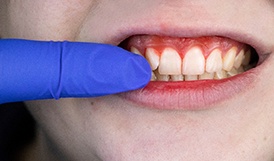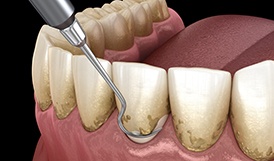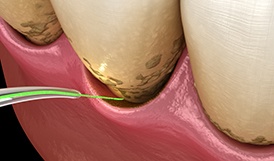Gum Disease Treatment – Framingham
Healthy Gums to Support Strong Teeth
Periodontal (gum) disease is one of the most common oral health concerns. According to some research, more than half of patients over the age of 30 have some form of gum disease. Unfortunately, gum disease is also the leading cause of tooth loss for patients in this demographic, so it’s important that you work with the skilled dentist and team at Framingham Premier Dental to prevent gum disease whenever possible. For patients who do experience gum disease that requires gum disease treatment, we offer services using state-of-the-art technologies to deliver painless results. Call our Framingham dentist and team to find out more or schedule an appointment with us. We look forward to seeing you soon.
What Is Gum Disease?

The word periodontal is actually a combination of two words, “perio” meaning around and “odont” meaning tooth. Gum disease refers to the infection or damage of tissues that surround and support teeth. This includes the soft gum tissue as well as supportive alveolar bone tissue. When plaque and tartar builds up at or around the gums, the sticky, acidic biofilms irritate and damage these supportive tissues, leading to numerous oral health concerns and tooth loss in the most severe cases. There are two stages of gum disease. In the early stages, it’s often referred to as gingivitis, and patients may not notice any of the subtle warning signs of this oral health concern. In the advanced stages, known as periodontitis, the disease can be extremely detrimental to oral health.
Symptoms of Gum Disease

With six-month dental checkups, we should be able to prevent gum disease before it starts or begin treatments in the earliest stages, but for patients who do experience the more advanced forms of gum disease, any of the following side effects may be present:
- Bleeding gums, especially when brushing and flossing
- Swelling, inflammation, or infection in the soft tissue
- Teeth that shift or a bite that doesn’t seem to fit together properly
- Teeth that appear longer due to gum tissue recession
- Bad breath that doesn’t improve after cleaning
How Do We Treat Gum Disease?

After we determine the severity of the infection, one or multiple of the following treatment methods may be used to treat your gums.
Scaling & Root Planing

To prevent further infection, plaque and tartar buildups need to be removed via scaling and root planing. Scaling is the process of breaking down plaque from above and below the gumline. The planing part of the process involves smoothing down the tooth roots so they can more easily reattach to the teeth and heal. This treatment is usually completed in two separate visits.
Antibiotic Treatment

Antibiotics are often prescribed along with scaling and root planing. Even after your deep cleaning, some bacteria are left in the mouth, so antibiotics are great at fighting them off. During your visit, our team can explain the specifics of the antibiotics chosen and any instructions you need to follow.
Laser Periodontal Treatment

Laser treatments offer a number of benefits for patients in need of more advanced periodontal therapy. Some benefits you can expect from soft tissue laser treatment include:
- Reduced bleeding during and after treatment
- No need for sedatives thanks to the increased comfort of laser therapy
- No scalpels or sutures are needed to remove damaged tissue, plaque, or tartar
- Accelerated healing time with reduced risk for reinfection
- Greater treatment precision removes only the damaged tissues
Following gum disease treatment using soft tissue lasers, patients should make a complete recovery within 48 hours. Because the laser cauterizes as it treats, healing is significantly accelerated. Additionally, you should experience little to no bleeding or inflammation. Instead, you’ll see a flawless, healthy smile with minimized risk for infection and better chance to make a full recovery.
Chao Pinhole Technique

The Chao Pinhole Surgical Technique is a minimally invasive treatment used for treating gum recession. Unlike traditional grafting techniques, PST doesn’t use incisions or sutures. Instead, a needle is used to make a small hole in the existing gum tissue. Through this pinhole, special instruments are used to loosen the gum tissue, allowing us to expand and slide the gumline to cover exposed root structures.
Gum Disease FAQs
How Do I Know If I Have Gum Disease?
Between your biannual dental checkups, keep an eye out for abnormal dental symptoms, like tender, red, swollen, or bleeding gums. If these (or any other) warning signs of trouble surface, schedule an appointment with our Dallas dentist, Dr. Marianna Gaitsgory. Once she has the opportunity to conduct a comprehensive oral exam, she can determine if an infection is present and, if it is, the best way to eliminate it.
Is Gum Disease Considered an Emergency?
Taking the “wait and see” approach with gum disease can lead to serious consequences, so we don’t recommend doing so. That said, it usually doesn’t require same-day treatment either. The best thing to do if you are suspicious that you have gum disease is to give us a call and explain your symptoms. From there, we can determine the severity of the situation and if an emergency visit is necessary. For example, if your gums are throbbing and one or more of your teeth feel loose, we will schedule an appointment ASAP so we can alleviate your discomfort, eliminate the infection, and restore your healthy smile.
What are the Risks of Untreated Gum Disease?
In the beginning, the symptoms are relatively minor, like slight inflammation and redness. Overtime, however, the infection can destroy the supporting structures of your teeth, causing them to become loose or fall out completely. If that isn’t reason enough to take this oral health problem seriously, the infection can also spread throughout your body via your bloodstream, increasing your risk of heart disease, respiratory infections, and several other serious health issues in the process.
How Can I Prevent Gum Disease?
Fortunately, gum disease is largely preventable. The key is prioritizing preventive care, starting with your biannual dental checkups and cleanings. It’s also important that you take good care of your teeth at home – from brushing for two minutes each morning to flossing each night before you go to bed. Lastly, do your best to stick to a healthy, well-balanced diet so your body has the nutrients it needs to fight off infections.
Is Gum Disease Treatment Expensive?
If you need gum disease treatment, but you’re a bit worried that the cost won’t fit into your budget, don’t worry – there are several affordable payment options our patients can use to lower their out-of-pocket expenses. At your consultation, we will provide you with an estimate of the price after determining the severity of the infection and the type of treatment needed. Then, we will review the financial solutions available and help you decide which one is best for you.

